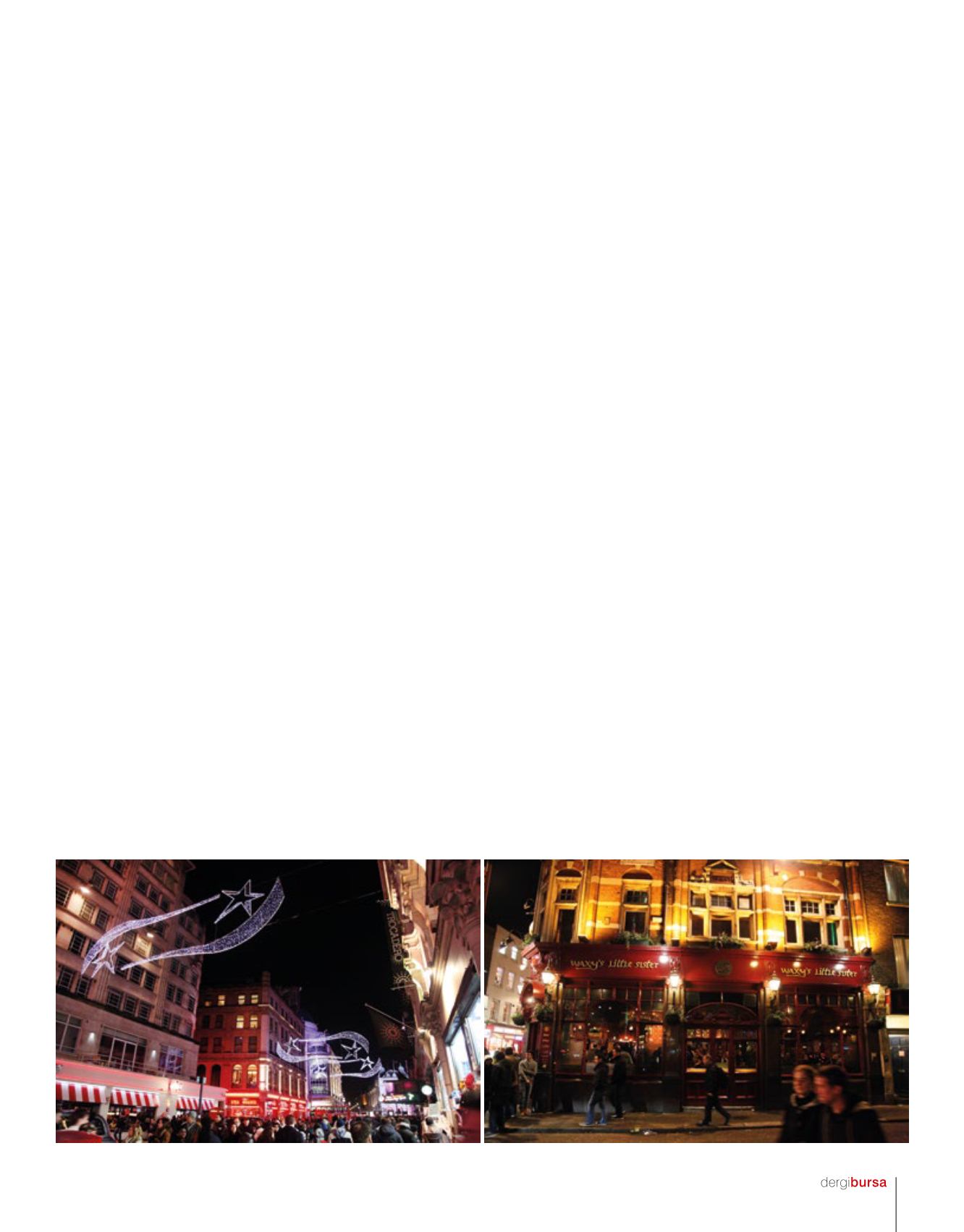
117
Bu yüzden Londra metrosuna
yani nam-ı diğer “Tube”a
ve aman ha adımına dikkat
demeye çalışan “Mind the Gap”
anonsuna alışmakta fayda var.
Londra'da metro “underground”
olarak yazılıp “tube” olarak
okunuyor. Farklı renklendirilmiş
12 hattın oluşturduğu renk
cümbüşü metro ağı pek akılda
kalıcı değil. Bu yüzden ilk iş
bir metro haritası edinmekte
ve hatta gitmeden üzerinde
biraz çalışmakta fayda var.
Dünyanın yer altından giden
ilk tren yolu olan Londra
Metrosu 1863 yılından bu
yana faaliyet gösteriyor. Bu
vesileyle bizim nostaljik Tünel
hattını da analım. Londra'nın
hemen ardından ikinci metro
hattını açmayı 1875'te akıl
etmişiz ama devamını pek
getirememişiz maalesef. Her
neyse biz konumuza dönelim...
Metroyu gişelerden alacağınız
biletler ya da toplu taşıma
kartları ile kullanabiliyorsunuz.
Londra toplu taşıma sisteminde
kullanılan bilet kartına verilen
isim Oyster. Depozito karşılığı
alacağınız Oyster kart,
İstanbul'daki Akbil gibi para
yüklenebilen ve kullanıldıkça
içindeki bakiyeden düşen bir
ödeme sistemi. Travelcard ise
adından da anlaşılacağı üzere
seyyahlar için planlanmış, belirli
sayıda gün için sınırsız kullanım
hakkı veren bir kart. Hangi
kartın doğru tercih olduğu,
toplu taşıma sisteminin kaç
defa, nerede ve hangi saatlerde
kullanılacağı ile doğru orantılı.
Biletinizi istasyona girişte ve
istasyondan ayrılırken ayrıca
okutmanız gerekiyor. Sistem
bu sayede sizin hangi “zone”u
kullandığınızı anlayabiliyor ve
hesabınızı kesiyor.
14 milyon nüfusuyla Avrupa
Birliği’nin en kalabalık şehri
unvanını taşıyan Londra, 40’tan
fazla üniversite, 5 uluslararası
havaalanı ve dünyanın en
gelişmiş metro sistemlerinden
biriyle sorumluluğunu yerine
getirmeye çalışıyor. Her ne
kadar metrosuyla ünlü olsa
da şehrin 24 saat çalışan
meşhur kırmızı otobüslerinin
700 hat üstünde 8 bin
araçla hizmet verdiğini ve
sadece haftaiçi taşıdığı insan
sayısının 6 milyonu geçtiğini
de unutmayalım. Dolayısıyla
konumuz Londra ulaşım
rehberi olunca meşhur kırmızı
otobüslerinden de bahsetmeli.
Otobüsler metroya göre daha
sakin. Hepsi yeni, bakımlı
ve klima sistemli. Bilet veya
kart makinesi şoförün hemen
yanında. Bindiğinizde otobüsün
hangi yöne gittiği, her duraktan
önce ise durak ismi anons
ediliyor ve dijital ekranda
görülüyor. Duraklardaki
ilk bakışta biraz karmaşık
görünen ama sonra kolaylıkla
alışabileceğiniz hareket ağı
ile otobüsler oldukça dakik,
metroyla yarışacak sıklıkta
ticket cards that are used for the
London public transport system.
The Oyster card, which you can
get against deposit, is like Akbil
in Istanbul that is a pre-paid
system which can be loaded (or
top-up as the Brits say) and used
according to the remaining credit..
Travelcard, on the other hand as
the name suggests, is planned for
travelers, it is a card which gives
you unlimited usage for a certain
number of days. To decide on
which card to be a correct choice
is directly proportional to how
many times, where and at which
hours the public transportaion
will be used. You have to swipe
your card as you enter and leave
the station. This way the system
knows in which “zone” you are
using the card and charges you
accordingly.
London, assuming the title of
being the most crowded city of
the European Community with
its 14 million population, is trying
to shoulder its responsibility
with more than 40 universities,
5 international airports and
the world’s most developed
underground system. Despite the
fact that London is famous for
its undergrounds, we should not
forget that the iconic red buses
that serve 24 hours, on over 700
routes with 8 thousand buses
and carries over 6 million people
a week. So, when our subject
matter is London transportation
guide, the well-known red buses
of London should be mentioned.
Compared to tube the buses
are more comfortable. All the
buses are new, well-kept and
air-conditioned. The ticket or the
card machine is right beside the
driver. Getting on the bus, the
destination and the name of the
station before the bus stops is
announced and shown on the
digital screen. Though might
seem a bit complex at first, it is
easy to adapt in a short time, and
the buses are quite punctual, as
frequent as the tube and offers a
comfortable trip. If we also think
of the relatively light traffic in the
center of London, these huge
red photogenic objects besides
walking can be an important
alternative for those who would
like to get away from the hussel
of the underground. (see also an
other photo object: red telephone
boots). Thus, you can not only see
the city and adapt yourself to the
joy of your trip above the ground,
but also travel anywhere you want
due to the extensity of the bus-
stops. When you come across
those who pay 20 pounds to the
“Hop on Hop Off” tourist buses,
you can even make fun of them…
Another icon of London is as
you know is the black taxi. It is
still possible to see the classic
oldest models in traffic. And
just as in buses, the tradition
is still carried on and the new
taxis with the same design rolls
on streets. It is also a must to
mention the double-decker bus
“number 15” as we talk about
the olds. Some of the those red
buses, which became active in
1954 and arised from service
in 2005, are still being used on
route 15. The number 15 route
is in service between Trafalgar
Square and Tower Hill. On this
route there are some important
spots such as St.Paul Church,
London Tower and Tower Bridge.


